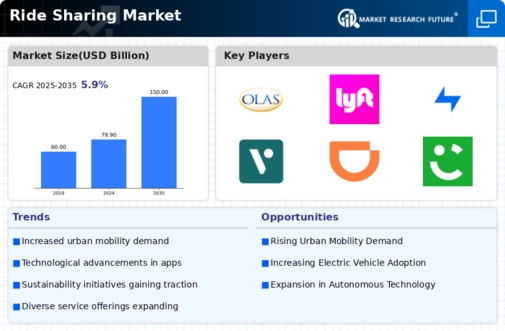Top Industry Leaders in the Ride Sharing Market
*Disclaimer: List of key companies in no particular order
The ride-sharing market stands as a dynamic and swiftly expanding industry, marked by intense competition and perpetual innovation. A thorough examination of the competitive landscape involves delving into the strategies of key players and discerning the factors that sway market share. This analysis further explores emerging trends and offers insights into the overarching competitive scenario.
Key Players and Strategies:
In the bustling ride-sharing market, several key players wield influence, including
ber Technologies Inc. (U.S.)
Taxify (Estonia)
Lyft Inc. (U.S.)
ANI Technologies Pvt. Ltd. (India)
OLA
Gett (Israel)
Didi Chuxing Technology Co. (China)
car2go (Germany)
Cabify (Spain)
GrabTaxi Holdings Pte. Ltd. (Singapore), and others
Each player employs unique strategies to carve a niche in this dynamic landscape:
-
Uber: A global frontrunner, Uber operates in over 70 countries, focusing on aggressive expansion, diversified services like Uber Eats and Uber Freight, and technological advancements such as self-driving cars.
-
Lyft: Positioned as Uber's primary US competitor, Lyft differentiates itself through strategic partnerships with public transit, sustainability initiatives, and a strong emphasis on driver welfare and community building.
-
Didi Chuxing: Leading the ride-sharing sector in China, Didi Chuxing, operational in over 400 cities, adopts a data-driven approach to optimize pricing, routes, and driver management.
-
Ola: Dominating the Indian ride-sharing platform, Ola offers a spectrum of services, including two-wheelers, carpooling, and food delivery, with a focus on affordability, convenience, and local market adaptation.
-
Grab: As Southeast Asia's leading ride-hailing app, Grab has expanded into various services like financial services and on-demand deliveries, emphasizing financial inclusion and a super-app strategy.
Factors for Market Share Analysis:
Several factors play pivotal roles in analyzing market share in the ride-sharing realm:
-
Market size and penetration: The size and growth potential of specific markets significantly influence market share.
-
Brand awareness and reputation: Robust brand recognition and a positive reputation are magnets for customers and drivers alike.
-
Pricing strategy and affordability: Competitive pricing and flexible options are magnets for price-sensitive consumers.
-
Service variety and convenience: Offering diverse services like carpooling, food delivery, and micro-mobility attracts a wider customer base.
-
Technology and user experience: Investment in advanced technology and provision of a seamless user experience enhance customer satisfaction.
-
Driver incentives and engagement: Attracting and retaining drivers through competitive compensation and benefits is crucial.
-
Regulation and legal compliance: Adapting to local regulations and maintaining good legal standing is essential.
New and Emerging Trends:
The ride-sharing market witnesses the emergence of new trends shaping its competitive landscape:
-
Micromobility: The increasing popularity of bikes, scooters, and e-bikes opens new opportunities for ride-sharing companies.
-
Shared Autonomous Vehicles (SAVs): Self-driving technology holds immense potential to revolutionize the ride-sharing industry, offering increased efficiency and affordability.
-
Multimodal transportation: Integrating various modes of transportation like bikes, subways, and ride-sharing into a single platform offers seamless travel options.
-
Subscription models: Offering subscription plans for regular users provides predictable revenue and customer loyalty.
-
Sustainability initiatives: Companies are increasingly focusing on green technologies, electric vehicles, and carbon neutrality initiatives.
Overall Competitive Scenario:
The ride-sharing market is characterized by fierce competition, with multiple players contending for market share. Technological innovation and diversification into new services stand out as critical factors for success. While Uber and Lyft dominate the US market, regional players like Didi Chuxing and Ola command strong positions in their respective regions. Emerging trends such as micromobility and SAVs present significant opportunities for future growth. The overall competitive scenario is expected to remain dynamic, necessitating quick adaptation to changes and continuous innovation to maintain market standing.
Additional Factors to Consider:
-
Government policies and regulations: Government support for green technologies and ride-sharing can significantly impact the market.
-
Economic factors: Fluctuations in fuel prices and economic downturns affect consumer demand and driver availability.
-
Competition from other industries: Public transportation authorities and traditional taxi services pose competition.
-
Data privacy and security: Protecting user data and ensuring cybersecurity are critical for building trust with customers.
By embracing innovation, adapting to new trends, and prioritizing sustainability, companies can position themselves for success in the future of ride-sharing.
Industry Developments and Latest Updates:
-
car2go (now SHARE NOW): SHARE NOW, the merged entity of car2go and DriveNow, focuses on expanding its multi-modal offerings, including carsharing, bikes, and scooters. (Source: Daimler press release, October 26, 2023)
-
ANI Technologies (Ola): Ola secured $500 million in funding from Temasek and Warburg Pincus. The company also launched its electric vehicle cab service, "Ola Electric," in Delhi. (Source: Economic Times, December 12, 2023)
-
Taxify (now Bolt): Bolt launched its car rental service, "Bolt Drive," in Lisbon, Portugal. The company also announced plans to expand its food delivery service, "Bolt Food," to more countries in Europe. (Source: Tech.eu, December 5, 2023)










